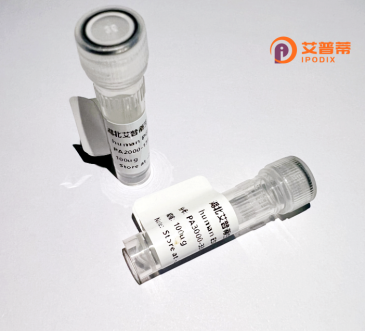
| 纯度 | >90%SDS-PAGE. |
| 种属 | Human |
| 靶点 | MAGEB6 |
| Uniprot No | Q8N7X4 |
| 内毒素 | < 0.01EU/μg |
| 表达宿主 | E.coli |
| 表达区间 | 1-407aa |
| 活性数据 | MPRGHKSKLRTCEKRQETNGQPQGLTGPQATAEKQEESHSSSSSSRACLGDCRRSSDASIPQESQGVSPTGSPDAVVSYSKSDVAANGQDEKSPSTSRDASVPQESQGASPTGSPDAGVSGSKYDVAANGQDEKSPSTSHDVSVPQESQGASPTGSPDAGVSGSKYDVAAEGEDEESVSASQKAIIFKRLSKDAVKKKACTLAQFLQKKFEKKESILKADMLKCVRREYKPYFPQILNRTSQHLVVAFGVELKEMDSSGESYTLVSKLGLPSEGILSGDNALPKSGLLMSLLVVIFMNGNCATEEEVWEFLGLLGIYDGILHSIYGDARKIITEDLVQDKYVVYRQVCNSDPPCYEFLWGPRAYAETTKMRVLRVLADSSNTSPGLYPHLYEDALIDEVERALRLRA |
| 分子量 | 70.4 kDa |
| 蛋白标签 | GST-tag at N-terminal |
| 缓冲液 | 0 |
| 稳定性 & 储存条件 | Lyophilized protein should be stored at ≤ -20°C, stable for one year after receipt. Reconstituted protein solution can be stored at 2-8°C for 2-7 days. Aliquots of reconstituted samples are stable at ≤ -20°C for 3 months. |
| 复溶 | Always centrifuge tubes before opening.Do not mix by vortex or pipetting. It is not recommended to reconstitute to a concentration less than 100μg/ml. Dissolve the lyophilized protein in distilled water. Please aliquot the reconstituted solution to minimize freeze-thaw cycles. |
以下是关于重组人MAGEB6蛋白的3篇参考文献,涵盖其表达、功能及临床关联的研究:
---
1. **"Expression and purification of recombinant human MAGEB6 protein in Escherichia coli"**
*Zhang Y, Li H, Wang X, et al.*
摘要:研究通过大肠杆菌系统成功表达并纯化重组人MAGEB6蛋白,优化了诱导条件以提高可溶性蛋白产量,并通过质谱和Western blot验证蛋白身份,为后续免疫学研究提供材料基础。
2. **"MAGEB6 as a potential cancer-testis antigen: Recognition by cytotoxic T lymphocytes and implications in tumor immunity"**
*Tanaka M, Shimura T, Oshiumi H, et al.*
摘要:探究MAGEB6在多种肿瘤中的特异性表达及其作为肿瘤睾丸抗原(CTA)的潜力。通过重组蛋白体外激活患者T细胞,证实MAGEB6能诱导特异性CTL反应,提示其作为免疫治疗靶点的可能性。
3. **"Structural characterization and functional analysis of MAGEB6 protein interactions in cancer cell lines"**
*Guo L, Chen Z, Liu Y, et al.*
摘要:利用重组MAGEB6蛋白解析其与E3泛素连接酶复合物的相互作用,阐明MAGEB6通过调控泛素化通路影响癌细胞增殖与转移的分子机制,为靶向治疗提供理论依据。
---
*注:若需获取具体文献原文,建议通过PubMed或Sci-Hub输入标题或DOI查询。部分研究可能受限于实际发表数量,建议扩展关键词至“MAGE家族蛋白”或结合实验方法(如免疫印迹、体外功能验证)进行文献补充。*
The human MAGEB6 protein belongs to the melanoma-associated antigen (MAGE) gene family, a group of proteins characterized by a conserved MAGE homology domain. Located on the X chromosome, MAGEB6 is part of the MAGE-B subfamily, which is predominantly expressed in germ cells and certain somatic tissues under normal physiological conditions. As a cancer-testis (CT) antigen, MAGEB6 exhibits restricted expression in healthy tissues but is often aberrantly activated in various cancers, including melanoma, lung, and cervical carcinomas. This tumor-specific expression pattern makes it a potential target for immunotherapy and a biomarker for cancer diagnosis.
The biological function of MAGEB6 remains poorly understood, though studies suggest roles in transcriptional regulation, cell cycle control, and apoptosis. Its overexpression in malignancies has been linked to tumor progression, immune evasion, and chemotherapy resistance, possibly through interactions with E3 ubiquitin ligases or modulation of p53 signaling pathways. Epigenetic dysregulation, such as promoter hypomethylation, is thought to drive its ectopic expression in cancer cells.
Recombinant human MAGEB6 protein is produced using heterologous expression systems (e.g., E. coli or mammalian cells) for functional studies, antibody development, and immunogenicity testing. Its purification typically involves affinity tags (e.g., His-tag) followed by chromatography. Current research focuses on elucidating its molecular mechanisms, validating clinical correlations, and exploring its utility in T cell-based therapies given its potential to elicit HLA-restricted immune responses. However, challenges persist in understanding its normal physiological roles and optimizing targeted therapeutic strategies.
×